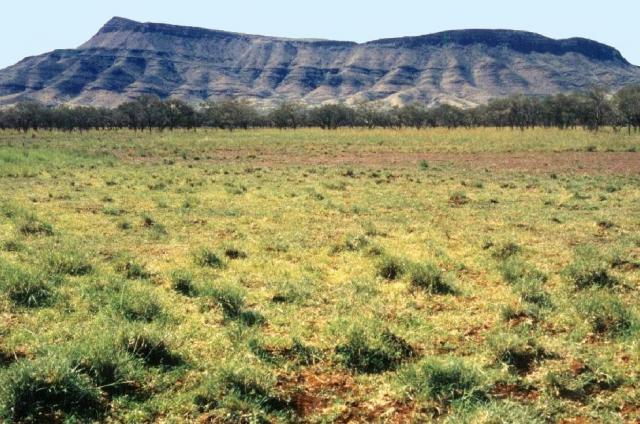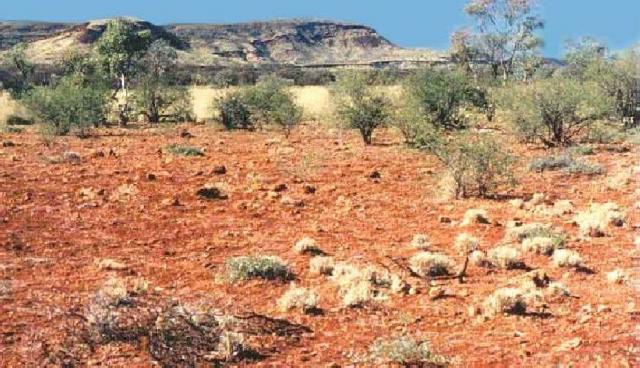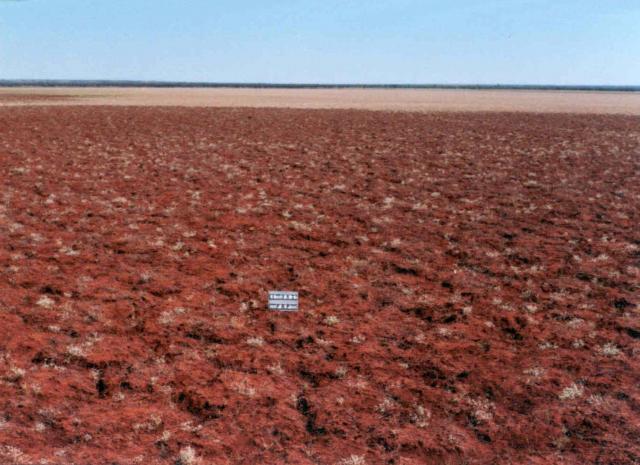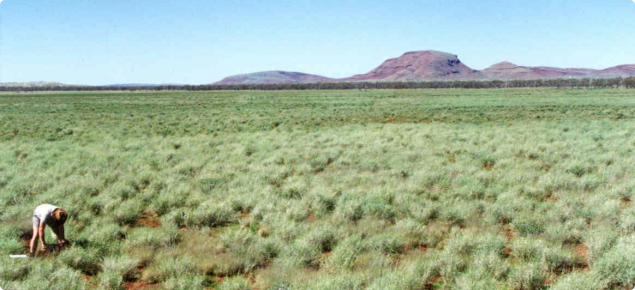Pasture potential
In good condition these pastures are of very high pastoral value. Mitchell grasses are the most palatable native grasses and are generally heavily grazed. Other grasses, herbaceous perennials and annuals associated with the Mitchell grasses also provide good quality forage for much of the year. Mitchell grass alluvial plain pasture in good condition can be grazed year–long (at appropriate stocking rates) by all classes of stock.
Suggested levels of use (per annum)
- Good condition: 15 hectares per cattle unit (ha/cu)
- Fair condition: 30 ha/cu
- Poor condition: 45 ha/cu
Managing Mitchell grass alluvial plain pastures in the Pilbara
Grazing management
Mitchell grasses seed readily and the seedlings appear regularly but most do not survive. Grazing animals often trample or pull seedlings out of the crumbly-surfaced soil. The adult tussocks suffer the same fate but to a lesser degree. If this continues year after year without spelling, a population will eventually disappear, especially in poor seasons.
Mitchell grass pastures in fair or poor condition require resting from grazing for at least a year, if not two. Degraded Mitchell grass pastures that are protected from grazing generally recover fairly rapidly, if sufficient plants remain to supply a seed source.
Fire management
Mitchell grass pastures have traditionally been protected from fire. However, burning can encourage more even utilisation in large paddocks, rejuvenate rank pasture, and encourage a temporary increase in the legume and annual component, which may improve nutritional quality. We recommend a minimum of 5 years between fires. Burn late in the year, for example immediately after the first storms, when the fire danger index is moderate.
Pasture condition
The condition of these pastures is assessed by observing the degree of ground cover (% basal cover) afforded by the grass tussocks, the vigour of the tussocks, age structure of the stand, the proportion of undesirables in the stand and the condition of the soil surface.
Traverse data (47 observations) during the Pilbara rangeland survey 1995-97 recorded:
Pasture condition: very good 13%, good 21%, fair 19%, poor 17%, very poor 30%.
Soil erosion: nil 92%, slight 0%, minor 2%, moderate 2%, severe 2%, extreme 2%.
The evidence is that the condition of Mitchell grass alluvial plain pastures is highly variable, and that substantial parts are seriously degraded. Where there has been a long grazing history, and Mitchell grass occurred in small areas as part of a mosaic with other less palatable pasture types, it has been removed by preferential grazing. However, where it occurs over larger areas distant from water, this pasture type can still be found in good condition. Soil erosion is uncommon due to flat topography and heavy textured soils, but is a problem in some localised areas.
Very good–good condition
In good condition (Figure 1) the basal cover of Mitchell grass tussocks will be in the range of about 3 to 6% and there should also be some young age classes in the stand. There should also be a range of useful perennial herbs such as Mardie clover (Rhyncosia minima) and sensitive plant (Neptunia dimorphantha).

Fair condition
In fair condition (Figure 2) this pasture type has a reduced population of Mitchell grasses and basal cover of the tussocks varies from about 1 to 3%. The populations of other palatable perennials also decrease while those of intermediate or undesirable plants may increase marginally.

Poor–very poor condition
In poor condition (Figures 3, 4) the population of Mitchell grass has largely disappeared with only isolated plants remaining. The population of herbaceous perennials has largely disappeared and there can be an increase in unpalatable perennials and annuals.


Vegetation structure and composition
This pasture type occurs as tussock grasslands on open treeless plains that may extend for 2 or 3 km, or as considerably smaller patches within stony plains and associated with Roebourne Plains grass pasture.
The tussock grasses consist mostly of barley Mitchell grass (Astrebla pectinata) and weeping Mitchell grass (Astrebla elymoides) with a few other perennial grasses such as Roebourne Plains grass (Eragrostis xerophila), ribbon grass (Chrysopogon fallax) and neverfail (Eragrostis setifolia), and numerous herbs and forbs in season. Curly Mitchell grass (Astrebla lappacea) is found on the Hamersley Plain, the only location where it is known in Western Australia.
Shrubs are usually absent or isolated but occasionally there is a scattered to moderately close layer of snakewood (Acacia xiphophylla) with a projected foliage cover (PFC) of 10 to 25%.
Occurrence
This pasture is occasionally found in the alluvial valleys of the Fortescue River and its tributaries on such land systems as Brockman, Coolibah, Elimunna, Fortescue, Hooley and Kanjenjie. It occurs on level plains with gilgai microrelief and deep cracking clay soils with crumbly self-mulching surfaces. Surface mantles are absent or few to common (2–20%) as pebbles of ironstone and other rocks.
Associated plants
| Common name (link to DPIRD species page) | Scientific name (link to FloraBase) | Life form |
|---|---|---|
Decreasers (desirables) | ||
| Bastard marshmallow | Abutilon malvifolium | perennial herb or shrub |
| Weeping Mitchell grass | Astrebla elymoides | perennial grass |
| Curly Mitchell grass | Astrebla lappacea | perennial grass |
| Astrebla pectinata | perennial grass | |
|
| Commelina ensifolia | perennial or annual herb |
| Chrysopogon fallax | perennial grass | |
|
| Desmodiopsis campylocaulon (syn. Desmodium campylocaulon) | annual herb |
| Dichanthium fecundum | perennial grass | |
| Eragrostis setifolia | perennial grass | |
| Eragrostis xerophila | perennial grass | |
|
| Glycine falcata | perennial herb |
|
| Goodenia pascua | perennial herb |
| Sensitive plant | Neptunia dimorphantha | perennial herb or shrub |
| Rhyncosia minima | perennial herb or climber | |
| Senna hamersleyensis | perennial shrub | |
| Sida fibulifera | perennial herb or shrub | |
| Themeda triandra | perennial grass | |
|
| Vigna sp. Hamersley Clay (previously called Vigna sp. ‘Pilbara black soil’) | |
Increasers (undesirables) | ||
| Aristida latifolia | perennial grass | |
| Poison morning glory | Ipomoea muelleri | perennial herb |
| Senna artemisioides subsp. helmsii | perennial shrub | |
| Black soil poison | Stemodia kingii | perennial herb |
| Stinkweed | Streptoglossa bubakii | perennial herb |
| Stinkweed | Streptoglossa odora | perennial herb |
Intermediates | ||
|
| Crotalaria dissitiflora subsp. benthamiana | annual herb |
| Black soil bindweed | Polymeria lanata | perennial herb |
|
| Sida rohlenae | perennial shrub |
No indicator value (stability desirables) | ||
| Mimosa bush | Vachellia farnesiana (syn. Acacia farnesiana) | tree or shrub |
| Acacia victoriae | shrub or tree | |
| Snakewood | Acacia xiphophylla | shrub or tree |
Other resources
van Vreeswyk, AM, Leighton, KA, Payne, AL, & Hennig, P 2004, An inventory and condition survey of the Pilbara region, Western Australia, Department of Agriculture and Food, Western Australia, Perth. Technical Bulletin 92.

